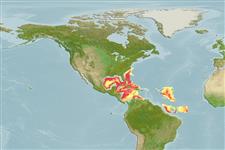Ikan bertulang rawan (sharks and rays) >
Rajiformes (Skates and rays) >
Gurgesiellidae (Pygmy skates)
Etymology: Fenestraja: Latin, fenestra, -ae = small hole or opening in a bone + Latin, raja, -ae = a fish, Raja sp. (Ref. 45335).
Environment: milieu / climate zone / depth range / distribution range
Ekologi
laut batidemersal. Deep-water
Western Central Atlantic: Bahamas and the Florida Keys.
Size / Weight / umur
Maturity: Lm ? range ? - ? cm
Max length : 22.0 cm TL (female)
Tail posterior to the tips of the pelvic fins. Prickles on disc and tail are not densely pigmented. Dark marking on disc and tail. Upper surface of disc pale brown. Lower surface pale yellowish without dark markings (Ref. 6902).
Solitary (Ref. 26340). Oviparous (Ref. 50449). Eggs have horn-like projections on the shell (Ref. 205).
Oviparous, paired eggs are laid. Embryos feed solely on yolk (Ref. 50449).
McEachran, J.D. and K.A. Dunn, 1998. Phylogenetic analysis of skates, a morphologically conservative clade of elasmobranchs (Chondrichthyes: Rajidae). Copeia 1998(2):271-290. (Ref. 27314)
Status IUCN Red List (Ref. 130435: Version 2024-1)
ancaman kepada manusia
Harmless
penggunaan manusia
Alat, peralatan
laporan khas
muat turun XML
Sumber internet
Estimates based on models
Preferred temperature (Ref.
123201): 4.1 - 8.8, mean 4.7 °C (based on 200 cells).
Phylogenetic diversity index (Ref.
82804): PD
50 = 0.5039 [Uniqueness, from 0.5 = low to 2.0 = high].
Bayesian length-weight: a=0.00661 (0.00222 - 0.01969), b=2.95 (2.71 - 3.19), in cm total length, based on LWR estimates for this (Sub)family-body shape (Ref.
93245).
Trophic level (Ref.
69278): 3.7 ±0.5 se; based on size and trophs of closest relatives
Daya lenting (Ref.
120179): Rendah, Waktu penggandaan populasi minimum 4.5 - 14 tahun (Fec assumed to be <100).
Fishing Vulnerability (Ref.
59153): Low vulnerability (12 of 100).
